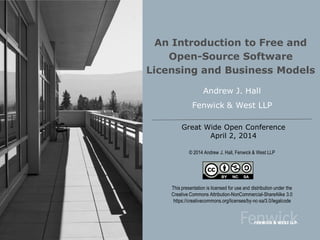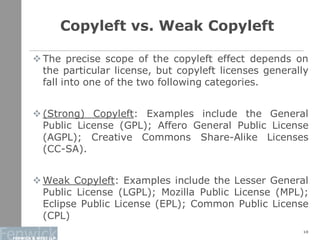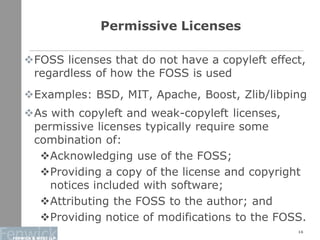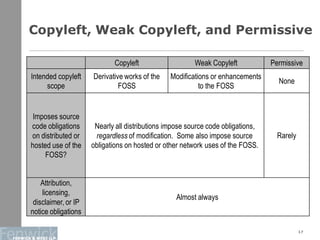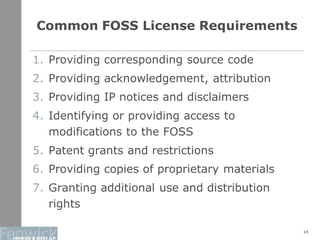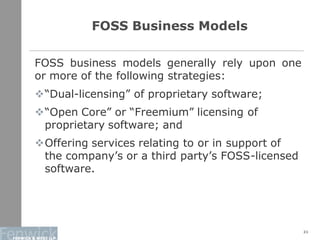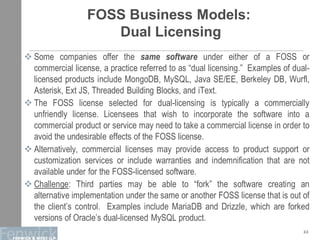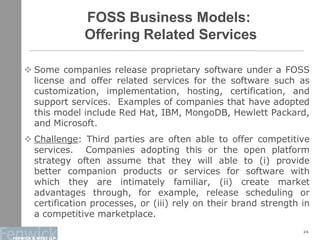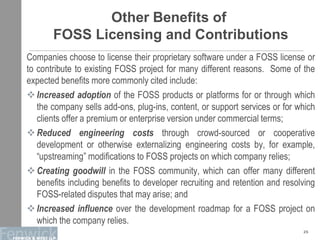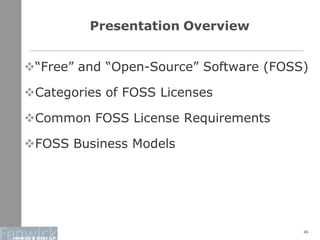An Introduction to Free and Open Source Software Licensing and Business Models
- 1. Great Wide Open Conference April 2, 2014 An Introduction to Free and Open-Source Software Licensing and Business Models Andrew J. Hall Fenwick & West LLP This presentation is licensed for use and distribution under the Creative Commons Attribution-NonCommercial-ShareAlike 3.0 https://creativecommons.org/licenses/by-nc-sa/3.0/legalcode © 2014 Andrew J. Hall, Fenwick & West LLP
- 2. 2 Presentation Overview “Free” and “Open-Source” Software (FOSS) Categories of FOSS Licenses Common FOSS License Requirements FOSS Business Models
- 3. “Free” and “Open-Source” Software 3
- 4. “Free” and “Open Source” Software 4 Free Software Foundation: “Free Software” (four freedoms) Open Source Initiative (OSI.org): The “Open Source” Definition (ten requirements) Also referred to a “OSS,” “FOSS,” and “FLOSS.” FOSS License Examples: GNU General Public License (GPL) GNU Lesser General Public License (LGPL) Mozilla Public License (MPL) Eclipse Public License (EPL) MIT and BSD Licenses Apache Software License
- 5. Common usage of “open source” and “FOSS” 5 Software made available: 1. to the public; 2. in source code form; and 3. under a standard, non-negotiated license. May be more accurately referred to as “public source” licensing
- 6. FOSS is not Public Domain 6 Public domain software is software: 1. That the copyright holder has explicitly dedicated to the public; or 2. For which the copyright term has expired. Public Domain software can be used without a license and without restriction. FOSS is licensed software that must be used in accordance with the terms of the applicable FOSS license(s).
- 7. How FOSS licensing differs from commercial software licensing 7 FOSS Licensing Commercial Software Licensing Software from many different licensors is licensed to the general public under standard, non-negotiable licenses. Licensing terms are often negotiable and vary by provider, customer, purchased products and services, and intended use. Software is delivered in source form and licensed for source or binary use. Software is typically delivered in binary form and licensed only for binary use. Licenses generally permit modification, subject to varying obligations and restrictions. Licenses typically include prohibitions on reverse-engineering and modification of the software. Licenses generally permit royalty-free redistribution of the software, subject to varying obligations and restrictions. Licenses typically prohibit or impose royalty fees on redistribution of the licensed software. Licenses generally include explicit disclaimers of warranty and liability for downstream use of the software. License may include warranties and indemnification from the licensor. Ownership interests in the software are often distributed among many contributors. Ownership interest in the software is typically consolidated in a single entity.
- 8. Categories of FOSS Licenses 8
- 9. What is Copyleft? 9 Copyleft (aka viral or hereditary) licenses require that software combined with the copyleft software be made available to (a) in source code form and (b) under the terms of the same copyleft license. Open-source licensing of proprietary software can effectively preclude collecting license fees for the combined software, but does not prevenet revenue generation using the software.
- 10. Copyleft vs. Weak Copyleft 10 The precise scope of the copyleft effect depends on the particular license, but copyleft licenses generally fall into one of the two following categories. (Strong) Copyleft: Examples include the General Public License (GPL); Affero General Public License (AGPL); Creative Commons Share-Alike Licenses (CC-SA). Weak Copyleft: Examples include the Lesser General Public License (LGPL); Mozilla Public License (MPL); Eclipse Public License (EPL); Common Public License (CPL)
- 11. Licenses with a viral or hereditary effect where derivative works must be licensed in source form under the same copyleft license. Examples: AGPL, GPL, EUPL, Creative Commons Share-Alike (CC SA), Berkley DB (Sleepycat) License The viral effects of many copyleft licenses (including the GPL) are triggered by distribution of the copyleft software (aka are subject to the “SaaS Loophole”) Closed-source companies often strictly scrutinize the use of copyleft software to avoid losing exclusive rights to their proprietary software. (Strong) Copyleft Licenses 11
- 12. Weak-Copyleft Licenses Licenses that require modifications or enhancements to (as opposed to derivative works of) the weak-copyleft FOSS to be made available (a) in source code form and (b) under the terms of the same weak-copyleft license. Often used for licensing software libraries. Examples: LGPL, MPL, CPL, EPL, CDDL As with copyleft FOSS licenses the viral effects of most weak-copyleft FOSS licenses are triggered by distribution of the weak-copyleft FOSS. 14
- 13. Weak-Copyleft Modifications Use of weak-copyleft FOSS is often closely scrutinized by closed-source companies to ensure that sensitive proprietary code not intended for public use or consumption is not considered a modification (or equivalent term) under the FOSS license, which typically depends on whether the FOSS is: 1. Linked to (used as a library) or directly combined with proprietary software; or 2. Dynamically linked or statically linked to by the proprietary software. 15
- 14. Permissive Licenses FOSS licenses that do not have a copyleft effect, regardless of how the FOSS is used Examples: BSD, MIT, Apache, Boost, Zlib/libping As with copyleft and weak-copyleft licenses, permissive licenses typically require some combination of: Acknowledging use of the FOSS; Providing a copy of the license and copyright notices included with software; Attributing the FOSS to the author; and Providing notice of modifications to the FOSS. 16
- 15. Copyleft, Weak Copyleft, and Permissive 17 Copyleft Weak Copyleft Permissive Intended copyleft scope Derivative works of the FOSS Modifications or enhancements to the FOSS None Imposes source code obligations on distributed or hosted use of the FOSS? Nearly all distributions impose source code obligations, regardless of modification. Some also impose source obligations on hosted or other network uses of the FOSS. Rarely Attribution, licensing, disclaimer, or IP notice obligations Almost always
- 16. Common FOSS License Requirements 18
- 17. Common FOSS License Requirements 19 1. Providing corresponding source code 2. Providing acknowledgement, attribution 3. Providing IP notices and disclaimers 4. Identifying or providing access to modifications to the FOSS 5. Patent grants and restrictions 6. Providing copies of proprietary materials 7. Granting additional use and distribution rights
- 19. 21 FOSS Business Models FOSS business models generally rely upon one or more of the following strategies: “Dual-licensing” of proprietary software; “Open Core” or “Freemium” licensing of proprietary software; and Offering services relating to or in support of the company’s or a third party’s FOSS-licensed software.
- 20. FOSS Business Models: Dual Licensing Some companies offer the same software under either of a FOSS or commercial license, a practice referred to as “dual licensing.” Examples of dual- licensed products include MongoDB, MySQL, Java SE/EE, Berkeley DB, Wurfl, Asterisk, Ext JS, Threaded Building Blocks, and iText. The FOSS license selected for dual-licensing is typically a commercially unfriendly license. Licensees that wish to incorporate the software into a commercial product or service may need to take a commercial license in order to avoid the undesirable effects of the FOSS license. Alternatively, commercial licenses may provide access to product support or customization services or include warranties and indemnification that are not available under for the FOSS-licensed software. Challenge: Third parties may be able to “fork” the software creating an alternative implementation under the same or another FOSS license that is out of the client’s control. Examples include MariaDB and Drizzle, which are forked versions of Oracle’s dual-licensed MySQL product. 22
- 21. FOSS Business Models: Open Core / Open Platform Open Core/Freemium: Some companies offer standard versions of certain products under a FOSS license, while offering enhanced or “enterprise” versions of the software under a commercial license. Examples include Sendmail Sentrion, Sourcefire Snort, and Alfresco’s CMS software. Open Platform: Some companies release a platform or other software under a FOSS license and offer proprietary plug-ins, extensions, modules, and add-ons under commercial licensing terms. Examples include the Eclipse platform (IBM), Android, Adobe Flex, and the Drupal, Joomla, and Wordpress CMS platforms. Challenge: Third parties are often able to offer competitive commercial products and services for the same open platform. 23
- 22. FOSS Business Models: Offering Related Services Some companies release proprietary software under a FOSS license and offer related services for the software such as customization, implementation, hosting, certification, and support services. Examples of companies that have adopted this model include Red Hat, IBM, MongoDB, Hewlett Packard, and Microsoft. Challenge: Third parties are often able to offer competitive services. Companies adopting this or the open platform strategy often assume that they will able to (i) provide better companion products or services for software with which they are intimately familiar, (ii) create market advantages through, for example, release scheduling or certification processes, or (iii) rely on their brand strength in a competitive marketplace. 24
- 23. Other Benefits of FOSS Licensing and Contributions Companies choose to license their proprietary software under a FOSS license or to contribute to existing FOSS project for many different reasons. Some of the expected benefits more commonly cited include: Increased adoption of the FOSS products or platforms for or through which the company sells add-ons, plug-ins, content, or support services or for which clients offer a premium or enterprise version under commercial terms; Reduced engineering costs through crowd-sourced or cooperative development or otherwise externalizing engineering costs by, for example, “upstreaming” modifications to FOSS projects on which company relies; Creating goodwill in the FOSS community, which can offer many different benefits including benefits to developer recruiting and retention and resolving FOSS-related disputes that may arise; and Increased influence over the development roadmap for a FOSS project on which the company relies. 25
- 24. 26 Presentation Overview “Free” and “Open-Source” Software (FOSS) Categories of FOSS Licenses Common FOSS License Requirements FOSS Business Models
- 25. Thank you! Questions? Andrew J. Hall Fenwick & West LLP 650-335-7644 [email protected]

